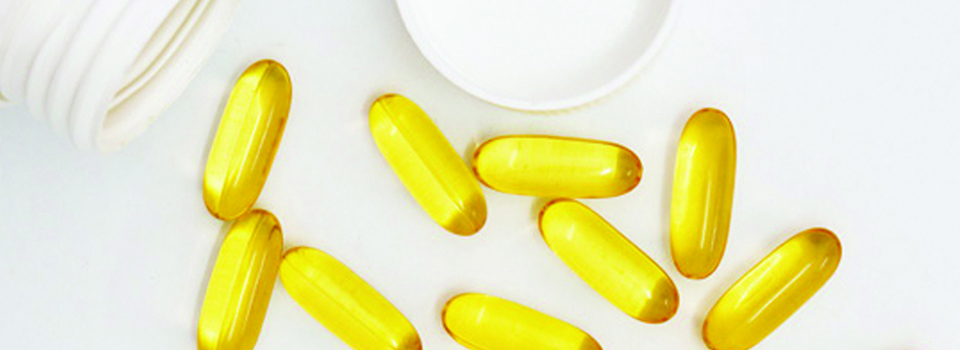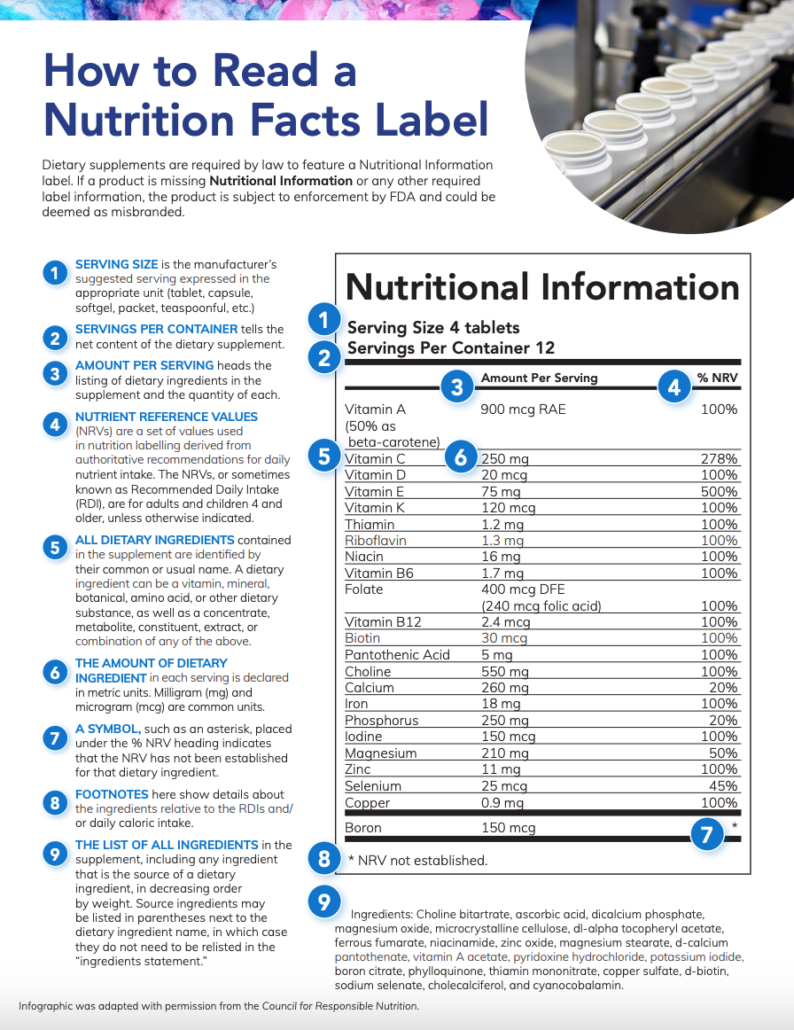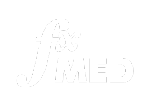Purchasing a supplement on your own can feel overwhelming. Whether at a store or online, you're faced with what feels like hundreds of options with different ingredients, price points, and dosages.
Food supplements can be powerful tools for your health, but it is mostly up to the individual supplement manufacturer to ensure quality and efficacy. Since quality is not always guaranteed, it's critical for you as the consumer to understand how and why to choose a trusted, well-respected brand.

To help you feel more confident about your supplements, here are the key things to look at when choosing a quality supplement:
Ingredient Information
Products sold as dietary supplements have to come with a supplement or nutritional facts label that lists the active ingredients or nutrients, the amount per serving, daily values, as well as other inactive ingredients that may be included, such as fillers, binders, and artificial colorings. The manufacturer suggests the serving size, but your healthcare provider might decide a different amount is more appropriate for you.
NRV
NRV is an abbreviation for ‘Nutrient Reference Value’. As a consumer, one may be more familiar with the old system of noting RDA’s (Recommended Daily Allowance) within the nutritional facts, but the values for RDA and NRV are exactly the same. Food supplement labels list the ingredients included in the product and give the proportion of the NRV value (% NRV) that is contained within the supplement (e.g., vitamin C, 80mg, 100% NRV). NRV’s are set for 13 vitamins and 14 minerals for the purposes of food labelling and are guidance levels on the daily amount of vitamin or mineral that the average healthy person needs to prevent deficiency. A supplement may promote itself as having an abundance of nutrients included, but upon review of the nutritional information, it is seen that the % NRV levels are quite low- just because it is included, does not always mean it is at an affective amount. If you are choosing products from a trusted brand, higher %NRV, sometimes even those over 100%, are significant because that is the level that is scientifically proven to provide a product’s claimed therapeutic effect.
Active vs. Inactive Ingredients
Like any food label, a product is required to list all comprised ingredients. In the case of food supplements, this is broken down into active and inactive or other ingredients. Ingredients are listed in the nutritional facts in decreasing order by weight or amount per serving where the active ingredients are generally those listed first as they are the nutrients that provide the effects in order to achieve therapeutic goals and health benefits.
Inactive ingredients are preservatives, fillers, artificial colors, or flavors. These are usually added to extend shelf life, change the appearance or taste, or reduce the cost of manufacturing. A common example of this is the widely used additive, magnesium stearate. Magnesium stearate is an inactive ingredient used by many supplement companies as an anticaking, lubricant agent that reduces the cost of manufacturing since its lubricating characteristics prevents ingredients from sticking to production equipment thus increasing the final yield of product. Although generally recognized as food safe, magnesium stearate is an unnecessary ingredient with no health benefits. However, the impact of long-term intake of this ingredient is still unclear.
High quality nutritional supplements are free from these unnecessary additives. While not a problem for everyone, inactive ingredients can include substances associated with adverse reactions for sensitive people. These additives could lead to reactions for people with food sensitivities, intolerances, or allergies. Some even have questionable long-term health implications.
A high-quality supplement minimizes the use of unnecessary additives and fillers to the end product, so you only get the specific ingredients you want.
Quality of Ingredients
Premium nutritional supplement companies will produce products using the bioidentical forms of nutrients as those are the most bioavailable. When we consume a vitamin or mineral, its bioavailability refers to the amount of the nutrient that has an active effect within our bodies. Put simply, the higher a nutrient’s bioavailability is, the more of it that will get sent to the parts of the body that need it.
Equally as important as the ingredients themselves are the bioavailability of those ingredients. Bioavailability basically refers to each nutrient’s ability to provide the desired effect in the body. When a nutrient has high bioavailability, it usually means the nutrient is in a form that is well absorbed and/or easily unitized by our cells.
A common example of bioavailability can be demonstrated when discussing the nutrient folate. Folate is an essential vitamin and therefore we must obtain it through diet or supplements. The most common form of folate used in supplements or fortified foods is folic acid. Folic acid is a distinctly man-made form of folate and is often used due to its stability and long shelf-life.
In order for folic acid to be used by our body, our cells must first convert folic acid into the active form of folate (i.e. methylated folate). However, many people contain a very common and often undetected genetic alteration (?mutation, polymorphism?) that prevents their cells from efficiently converting folic acid into the active form. Therefore, for many individuals, using a supplement containing folic acid to raise folate levels might not be effective. However, using a supplement that already contains the active form of folate (methylated folate) would have much higher bioavailability because it would already be easily utilized by our cells.
Put simply, the higher a nutrient’s bioavailability, the more effective it may be. Therefore, when finding a high-quality nutritional supplement, it’s important to assess each nutrient in the formulation to ensure it is a well-researched and highly bioavailable form. While it can be it can be difficult for the everyday consumer to easily identify if a supplement is leveraging high-quality, bioavailable nutrients, most companies that do use these types of ingredients will often mention this on their bottles or brand marketing materials. You can always consult your local pharmacist too to determine the quality of ingredients used in supplements.
To the everyday consumer, it can be difficult to easily identify if a supplement is leveraging high-quality, bioavailable nutrients, but companies that do use these types of highly effective ingredients will often illustrate this attention to detail on their bottles or brand marketing materials. You can always consult your local pharmacist too to determine the quality of ingredients used in supplements.

Is the Supplement Third-Party Verified?
Well-respected supplement manufacturers will seek out additional third-party testing if applicable to the local market and local regulations to help consumers feel more confident about the product. These reputable organizations will certify that what’s listed on the bottle is actually in the product, formulas are appropriate, all active and inactive ingredients are listed regardless of amount or do extensive testing to determine if products are actually free from common allergens or common intolerances and sensitivities (e.g., Certified Gluten-Free).
Nutritional supplements will generally note on the bottle if a product is third-party verified, but you can always consult your local pharmacist if it is unclear to you as the consumer.
FREE FROM Common Allergens
With the rise in food allergies and food sensitivities, keeping your supplements free from offending ingredients is vital for optimizing your health. If you have an allergy, intolerance, or sensitivity, even if a product doesn’t necessarily have an allergen in the supplement, you want to make sure it’s also free from cross-contamination
While there isn’t a single certification for hypoallergenic supplements, a high-quality company will have comprehensive standard operating procedures to prevent cross-contamination of allergens. They will also clearly label a product containing the top allergens such as soy, dairy, fish, or shellfish.
Further, if there is a chance an ingredient could have come into contact with an allergen, these products should be tested for exposure, and the company should be transparent about its practices.
If you have any reactions to foods or ingredients, it makes sense to look for a product that emphasizes the importance of creating hypoallergenic supplements.
Choose High-Quality Supplements to Support Your Health
Nutritional supplements made with only premium ingredients sourced from trusted suppliers and guided by nutritional experts can be highly effective, powerful tools to support your health. A high-quality supplement will provide the nutrients your body needs and should be FREE FROM unnecessary additives and many common allergens.
If you still find yourself needing some additional support in choosing a high-quality supplement that is right for you, it is always important to have a relationship with a healthcare practitioner who knows you and nutrition needs and can recommend what’s best for your health.

- EFSA Scientific Committee on Food; EFSA Scientific Panel on Dietetic Products, Nutrition and Allergies. “Tolerable Upper Intake Levels for Vitamins and Minerals”. Accessed 01 Dec 2021. www.efsa.europa.eu
- Hobbs, C. A., Saigo, K., Koyanagi, M., & Hayashi, S. M. (2017). Magnesium stearate, a widely-used food additive, exhibits a lack of in vitro and in vivo genotoxic potential. Toxicology reports, 4, 554–559. https://doi.org/10.1016/j.toxrep.2017.10.003
- Reker, Daniel, Steven M. Blum, Christoph Steiger, Kevin E. Anger, Jamie M. Sommer, John Fanikos, and Giovanni Traverso. “‘Inactive’ Ingredients in Oral Medications.” Science Translational Medicine 11, no. 483 (March 13, 2019): eaau6753. https://doi.org/10.1126/scitranslmed.aau6753.
- Tuck, Caroline J., Jessica R. Biesiekierski, Peter Schmid-Grendelmeier, and Daniel Pohl. “Food Intolerances.” Nutrients 11, no. 7 (July 22, 2019): E1684. https://doi.org/10.3390/nu11071684.
- Baan, Robertv, Kurt Straif, Yann Grosse, Béatrice Secretan, Fatiha El Ghissassi, Vincent Cogliano, and WHO International Agency for Research on Cancer Monograph Working Group. The Lancet. Oncology 7, no. 4 (April 2006): 295–96. https://doi.org/10.1016/s1470-2045(06)70651-9.
- Fairweather-Tait, Susan & Hurrell, Richard & Dael, P. & Dokkum, W. & Ducros, V. & Cashman, K. & Flynn, T.A. & Alegría, Amparo & Barbéra, R. & Farré, R. & Lagarda, M.Jesus & Macleod, F. & McGaw, B.A. & Sandström, B.. (1996). Bioavailability of Minerals and Trace Elements. Nutrition Research Reviews. 9. 295-324. 10.1079/NRR19960016.
- Fairweather-Tait, Susan & Hurrell, Richard & Dael, P. & Dokkum, W. & Ducros, V. & Cashman, K. & Flynn, T.A. & Alegría, Amparo & Barbéra, R. & Farré, R. & Lagarda, M.Jesus & Macleod, F. & McGaw, B.A. & Sandström, B.. (1996). Bioavailability of Minerals and Trace Elements. Nutrition Research Reviews. 9. 295-324. 10.1079/NRR19960016.
Share:
Related Posts

Goodbye Pie Chart, Hello Phase 1 Sliders
Written by Allison Smith, ND | 2025 As we usher in a new era of DUTCH testing which leaves behind the concept of the three-way

Introducing the DUTCH Dozen
Written by Kelly Ruef, ND | 2025 Hormone testing can be complex, which is why Precision Analytical developed the DUTCH Dozen, an interpretive framework that

DUTCH Report Enhancements
Written by Hilary Miller, ND | 2025 Precision Analytical have released the newest version of the DUTCH Test. This is the report’s most significant update

Gallbladder Health 101: What It Does and How to Keep It Working Well
Written by Ashley Palmer & Pooja Mahtani | 2025 The gallbladder may not get much attention compared to the gut, but it plays a central

Can You Bring Vitamins on a Plane? How To Travel with Supplements
Written by Austin Ruff | 2024 Are you traveling for a work conference, an athletic competition, or a weekend getaway? Just because you’re leaving home

